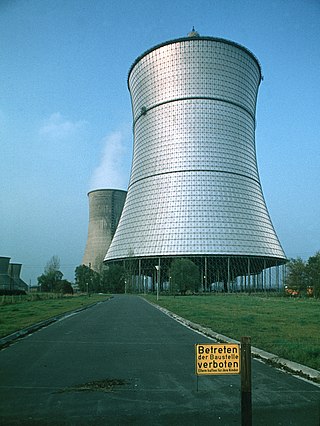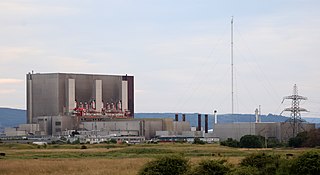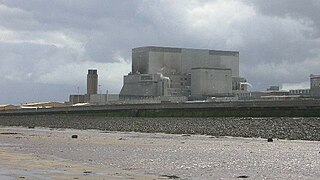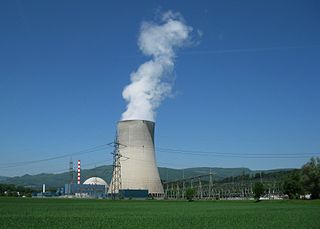
The Lucens reactor was a 6 MW experimental nuclear power reactor built next to Lucens, Vaud, Switzerland. After its connection to the electrical grid on 29 January 1968, the reactor only operated for a few months before it suffered an accident on 21 January 1969. The cause was a corrosion-induced loss of heat dispersal leading to the destruction of a pressure tube which caused an adjacent pressure tube to fail, and partial meltdown of the core, resulting in radioactive contamination of the cavern.

A nuclear power phase-out is the discontinuation of usage of nuclear power for energy production. Often initiated because of concerns about nuclear power, phase-outs usually include shutting down nuclear power plants and looking towards fossil fuels and renewable energy. Three nuclear accidents have influenced the discontinuation of nuclear power: the 1979 Three Mile Island partial nuclear meltdown in the United States, the 1986 Chernobyl disaster in the USSR, and the 2011 Fukushima nuclear disaster in Japan.

The THTR-300 was a thorium cycle high-temperature nuclear reactor rated at 300 MW electric (THTR-300) in Hamm-Uentrop, Germany. It started operating in 1983, synchronized with the grid in 1985, operated at full power in February 1987 and was shut down September 1, 1989. The THTR-300 served as a prototype high-temperature reactor (HTR) to use the TRISO pebble fuel produced by the AVR, an experimental pebble bed operated by VEW. The THTR-300 cost €2.05 billion and was predicted to cost an additional €425 million through December 2009 in decommissioning and other associated costs. The German state of North Rhine Westphalia, Federal Republic of Germany, and Hochtemperatur-Kernkraftwerk GmbH (HKG) financed the THTR-300’s construction.

Hartlepool nuclear power station is a nuclear power station situated on the northern bank of the mouth of the River Tees, 2.5 mi south of Hartlepool in County Durham, North East England. The station has a net electrical output of 1,185 megawatts, which is 2% of Great Britain's peak electricity demand of 60 GW. Electricity is produced through the use of two advanced gas-cooled reactors (AGR). Hartlepool was only the third nuclear power station in the United Kingdom to use AGR technology. It was also the first nuclear power station to be built close to a major urban area.

Hinkley Point B nuclear power station was a nuclear power station near Bridgwater, Somerset, on the Bristol Channel coast of south west England. It was the first commercial Advanced Gas Cooled reactor to generate power to the National Grid in 1976 and shares its design with sister station Hunterston B nuclear power station. It ceased operations permanently on 1 August 2022.

The Sizewell nuclear site consists of two nuclear power stations, one of which is still operational, located near the small fishing village of Sizewell in Suffolk, England. Sizewell A, with two Magnox reactors, is now in the process of being decommissioned. Sizewell B has a single pressurised water reactor (PWR) and is the UK's newest nuclear power station. A third power station, to consist of twin EPR reactors, is planned to be built as Sizewell C.

The Mochovce Nuclear Power Plant is a nuclear power plant located between the towns of Nitra and Levice, on the site of the former village of Mochovce, Slovakia. Two up-rated 470 MW reactors plus a 471 MW VVER 440 reactor are presently in operation, with a fourth of the same type under construction. In 2022 it generated almost 7,000 GWh of electricity, the power plant provided approximately 20% of Slovakia's electricity needs.
Nuclear power in Switzerland is generated by three nuclear power plants, with a total of four operational reactors (see list below). Since 1985, nuclear power has been contributing approximately 40% of Switzerland's electrical energy. In 2022, it produced 23 terawatt-hours (TWh) of electricity, and accounted for 37% of the nation's gross electricity generation of 62 TWh, while 55% was produced by hydroelectric plants and 8% came from conventional thermal power stations and non-hydro renewable energy sources.

Oldbury nuclear power station is a Magnox nuclear power station undergoing decommissioning. It is located on the south bank of the River Severn close to the village of Oldbury-on-Severn in South Gloucestershire, England. The ongoing decommissioning process is managed by Magnox Ltd, a subsidiary of the Nuclear Decommissioning Authority (NDA).

The Beznau nuclear power plant is a nuclear power plant of the Swiss energy utility Axpo, located in the municipality Döttingen, Canton of Aargau, Switzerland, on an artificial island in the Aare river. The plant has been operating since September 1969.

The Gösgen Nuclear Power Plant is located in the Däniken municipality on a loop of the Aar river. It is operated by the ad hoc society Kernkraftwerk Gösgen-Däniken AG.

The Mühleberg Nuclear Power Plant is a formerly operational nuclear power plant in the Mühleberg municipality in the canton of Bern, Switzerland. Operated by BKW FMB Energie AG, the plant generated power from 6 November 1972 until 20 December 2019. Nuclear decommissioning of the plant began January 2020 and is currently forecasted to be completed by 2034.

The Ågesta Nuclear Plant was the first Swedish commercial nuclear power plant built by ASEA. Also known as R3 nuclear reactor, it was the third nuclear reactor built in Sweden. Construction started in 1957 and ended in 1962, operations began in 1964 and continued until 1974.
Resun AG was a company located in Aarau (Switzerland). Its purpose was to manage the construction of two new nuclear reactors. These are unofficially known as Beznau 3 and Mühleberg 2 from the locations where they should be built. In August 2017 the company was liquidated.
In 2008, nuclear energy provided Switzerland with 40 percent of its electricity, but a survey of Swiss people found that only seven percent of respondents were totally in favor of energy production by nuclear power stations. Many large anti-nuclear demonstrations and protests have occurred over the years.

The Swiss Federal Nuclear Safety Inspectorate is Switzerland's regulatory supervisory authority for nuclear safety and for the security of nuclear installations; it supervises the nuclear power plants at Beznau, Gösgen, Leibstadt and Mühleberg, the research reactors at the Paul Scherrer Institute, the University of Basel and the Swiss Federal Institute of Technology, as well as the Swiss national central interim storage facility for radioactive waste (ZWILAG). ENSI's headquarters are located in Brugg in the Canton of Aargau.
The Niederamt Nuclear Power Plant was the name for a planned nuclear power plant near the existing Gösgen Nuclear Power Plant in Niederamt in the Canton of Solothurn between Olten and Aarau in Switzerland. The land earmarked for the project would have taken in some of the residential areas of Niedergösgen, Gretzenbach and Däniken.

The electricity sector in Switzerland relies mainly on hydroelectricity, since the Alps cover almost two-thirds of the country's land mass, providing many large mountain lakes and artificial reservoirs suited for hydro power. In addition, the water masses drained from the Swiss Alps are intensively used by run-of-the-river hydroelectricity (ROR). With 9,052 kWh per person in 2008, the country's electricity consumption is relatively high and was 22% above the European Union's average.

Axpo Holding AG, headquartered in Baden in the canton of Aargau, and its subsidiaries constitute the energy company Axpo. Axpo Holding AG was established in 2001, is 100-percent publicly owned and originates from the former Nordostschweizerischen Kraftwerke AG, NOK.
The site for the Kaiseraugst Nuclear Power Plant is located in north-west Switzerland beside the river at Kaiseraugst, a short distance to the east of Basel.





















